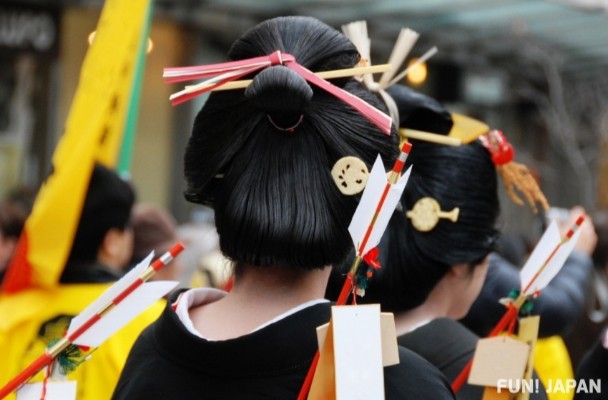Traditional Geisha - As Depicted in the Film, Memoirs of a Geisha
![[1 minute Video] What is a Geisha? Where can I Meet Japanese Geisha?](https://content.fun-japan.jp/renewal-prod/cms/articles/content/1jpg_2019-12-06-03-07-48.jpg)
The traditional geisha with memorable makeup, traditional Japanese hair and a kimono are people who entertain guests, also shown in the popular film "memoirs of a geisha", it is one of Japan's most famous traditions. In this article we would like to introduce you about the history of geisha, where you can see them, and what their job is.
What are Japanese Geisha?
![[1 minute Video] What is a Geisha? Where can I Meet Japanese Geisha?](https://content.fun-japan.jp/renewal-prod/cms/articles/content/2jpg_2019-12-06-03-07-58.jpg)
A geisha is a woman who typically works at something such as a traditional Japanese inn, food house etc and either sings and/or plays the shamisen or maybe even dances to entertain guests. In Kyoto they are called "Geiko" whilst in Kanazawa they are called "Geigi". To become a geisha you have to master a range of different skills including singing long songs, traditional Japanese dancing, tea ceremony skills, the ability to play the shamisen, and the ability to arrange flowers. For people who are currently learning to become a geisha, they are called "maiko" in Kyoto, and "Hangyoku" in Kanto.
The Origin of Geisha
The origins of the Geisha date back to the Edo period of Japan. It first began at a tea-house near the Yasaka shrine in Kyoto where women were dancing, singing, and playing the shamisen to entertain guests. Those women who danced and such to entertain guests received very high ratings in the Edo period. For this reason, a lot of tea-houses decided to hire women to entertain their guests also, eventually leading to the geisha we know today.
Where you can Meet Geisha in Japan Nowadays?
For towns which have a lot of geisha working at the various institutions, they are called "Hanamachi" in Japanese which can be translated as the "geisha quarter". There are quite a few of these different Hanamachi over Japan and as the evening starts to set in, it is here where you will be able to see geisha. However, since the geisha can be quite busy, please don't reach out to them for conversation. If you would like to see the geisha dance, there are countless places you can do so within these Hanamachi towns.
Kyoto's Gokagai, Preserving the Traditions and Formalities
![[1 minute Video] What is a Geisha? Where can I Meet Japanese Geisha?](https://content.fun-japan.jp/renewal-prod/cms/articles/content/3jpg_2019-12-06-03-08-19.jpg)
With Kyoto's largest town Gion Kōbu as the beginning, there are 4 other towns being Gionhigashi and Ponto-chō, Kamishichiken, and Miyagawa-chō. These are all towns that have always protected Japanese traditions and customs. There are even a lot of stores that decline first-time customers.
Tokyo's Geisha Districts, Asakusa and Kagurazaka
Tokyo's most famous geisha districts are Shibashi, Aksaka, Yoshicho, Kagurazaka, Asakusa, and Mukojima. Asakusa, which is also a very famous sightseeing spot used to house the eldest geisha "Yuuko neesan" up until 2017. Asakusa is a town that lives on with the spirit of Yuuko neesan and the geisha world.
Geisha's Dance in Asakusa
Geisha's traditional dance is held several times in a year for FREE in Asakusa. The singer in this video is a 94 year-old woman. So amazing!
- Time: First part 13: 00 ~ 13: 30, Second part 14: 30 ~ 15: 00
- Venue: Asakusa Culture and Tourism Center 6th floor multipurpose space *Right in front of Kaminarimon Gate
- Capacity: 85 seats / standing space is available up to 30 people
- Cost: FREE.
- Get the tickets at Asakusa Culture and Tourism Center 1st floor at 10 A.M.
The Tea-house Town and Geisha of Kanazawa
![[1 minute Video] What is a Geisha? Where can I Meet Japanese Geisha?](https://content.fun-japan.jp/renewal-prod/cms/articles/content/4jpg_2019-12-06-03-08-27.jpg)
In Kanazawa, there are 3 tea-house towns by the name of "Higashi", "Nishi", and "Kazuemachi", these 3 towns have had geisha working at their various institutions since the Edo period and continue the traditions and customs as they were back then. Typically most shops decline first-time customers, however there are times when geisha can be called at the local hotels and traditional Japanese inns. If you wish to see a geisha, we recommend checking with the facility prior to booking your stay!



Comments